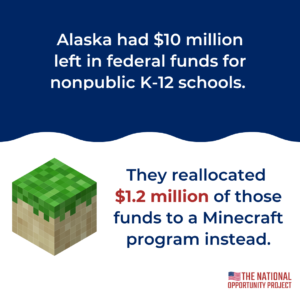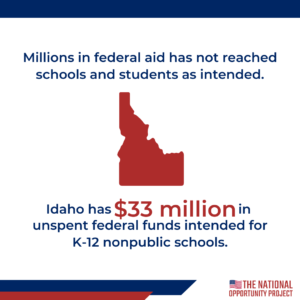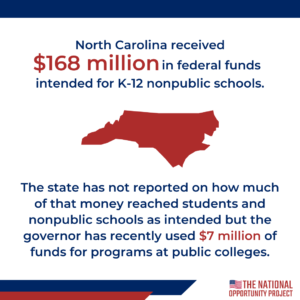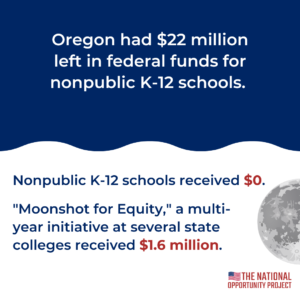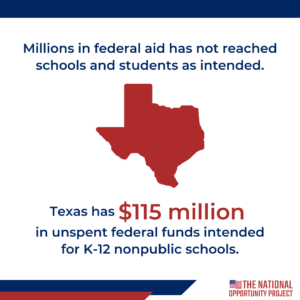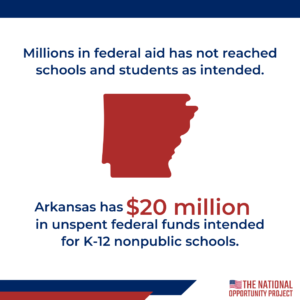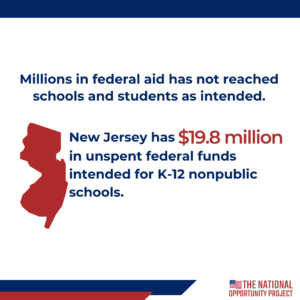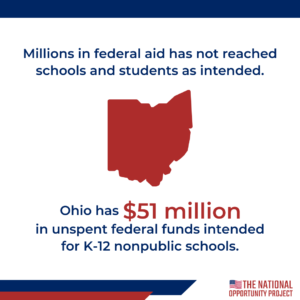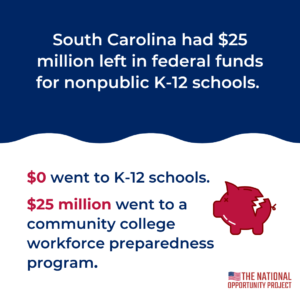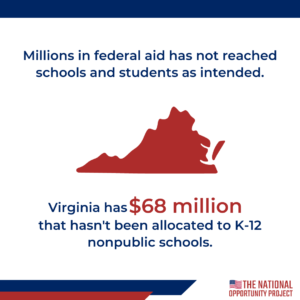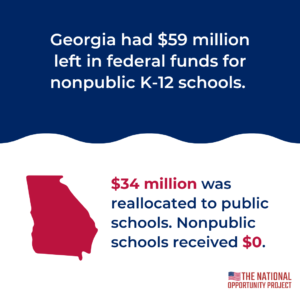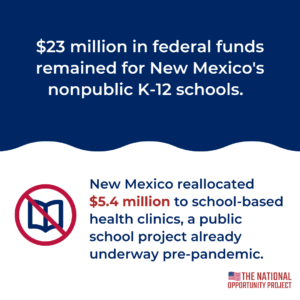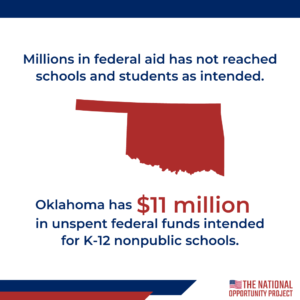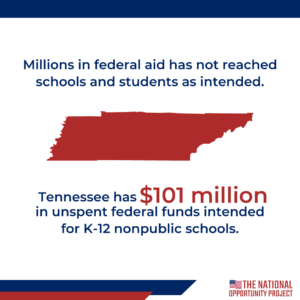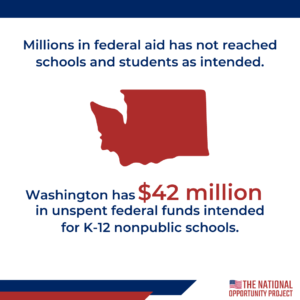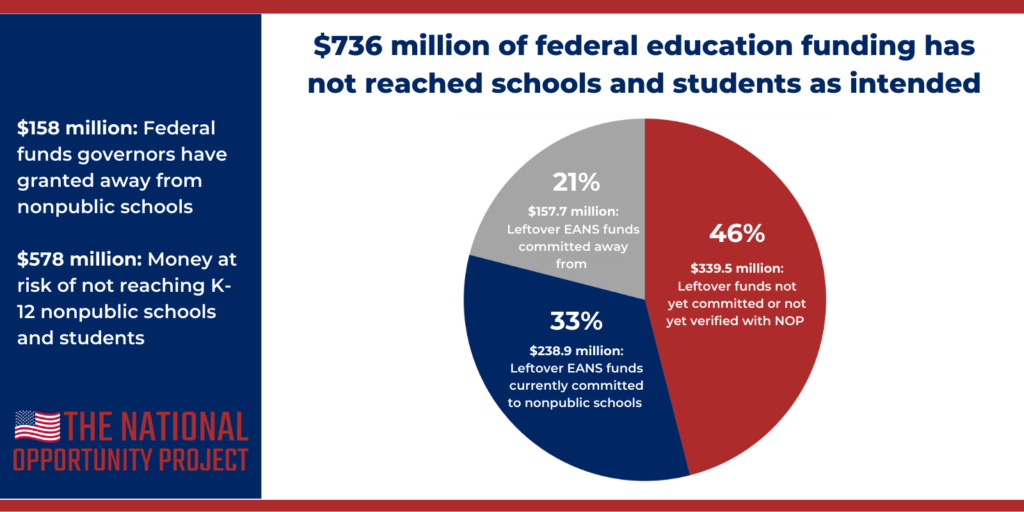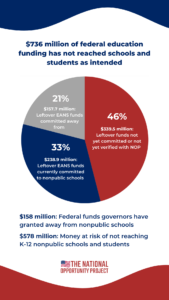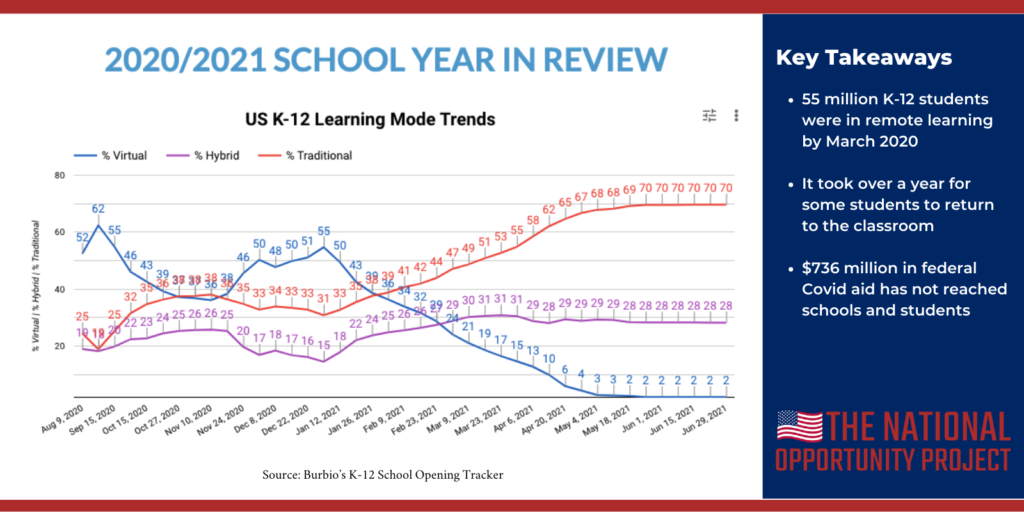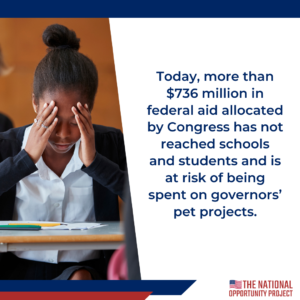From shutdown to shut out:
How America’s low-income students continue to be hurt by Covid policy
MARCH 2023
Jessica Hockett, PhD, Senior Policy Analyst
National Opportunity Project
It’s been three years since the government’s response to Covid upended Americans’ lives. And as time progresses, it is increasingly clear who will pay the steepest price for the pandemic: children.
To facilitate the reopening of K-12 schools, Congress made available nearly $200 billion through federal Covid relief starting in 2020. About 97% of this funding went to government-run public schools. After a push from stakeholders to acknowledge the harm of government-mandated closures on nonpublic schools, Congress created Emergency Assistance to Nonpublic Schools (EANS) and allocated $5.5 billion in aid to nonpublic schools with low-income students severely impacted by Covid.
However, today more than $736 million of this aid has failed to reach the schools and students as intended.
The National Opportunity Project has produced the nation’s first comprehensive look at the EANS program, with a focus on whether states have been able to get the money to the students and schools for which it was intended.

What's at stake: 27 states have at least $736 million in federal funds that governors can divert away from K-12 nonpublic schools
At least $157 million that states didn’t allocate to nonpublic schools has already ended up back in the hands of governors who reallocated the money to other public and private entities.
Whether these and similar grants made with leftover EANS money are good uses of federal funds in general matters far less than the issue of dollars intended for K-12 nonpublic schools going elsewhere.
Examples include:
- Alaska gave $1.2 million toward a program that uses the video game Minecraft to teach coding.
- Colorado directed $5 million to Colorado RISE Turnaround Fund Grants, which go to public schools and nonprofits, not nonpublic schools.
- Georgia put $34 million to grants for Georgia’s public schools.
- Kansas granted $6 million to a summer program that gives children and their families/caregivers free admission to museums, zoos, and historic sites.
- New Mexico granted $5.4 million to school-based health clinics, a public-school project already underway pre-pandemic.
- South Carolina gave $25 million to Workforce Scholarships for the Future, a community college workforce preparedness program.
- West Virginia used $500,000 for awards to 12 public schools that won a statewide “I Got Vaxxed!” competition.
- Oregon gave $1.6 million to “Moonshot for Equity,” a multi-year initiative aimed at “eliminating equity barriers” in several state colleges.
North Carolina used $7.7 million for mental health programs at public colleges and universities.
Key problems: Why students and schools missed out
Today, at least $736 million of federal aid has failed to reach the nonpublic schools and students it was intended for. Government mismanagement at federal and state levels ultimately kept qualified schools from accessing funds designated for them by Congress.
1. Some states used aid as a slush fund
Governors and state education agencies were disincentivized to allocate all the funding to nonpublic schools because of a little-discussed statutory spoiler (“reversion clause”) that allows money that doesn’t reach schools to be used by the governor for virtually any educational purpose.
2. Arbitrary program parameters led to poor implementation
States were left to decide how to notify schools of the program, calculate the impact of Covid on schools, and how to measure the low-income student enrollment in order to qualify for EANS funds. This resulted a lopsided and inconsistent distribution of funds.
3. Overly restrictive (and now moot) allowable expenses
While federal relief funds for public schools were essentially blank checks to all taxpayer- funded districts, funding for nonpublic schools was more restricted. Allowable uses were severely limited, emphasizing sanitation supplies, temporary air ventilation systems, and leasing space to ensure students and teachers were social distancing.
4. Exclusion of nonpublic schools that received paycheck assistance
Nonpublic schools that received a second-round Paycheck Protection Plan loan to help pay staff salaries were excluded from EANS eligibility. By contrast, public schools could use federal education aid totalling $190 billion (Elementary and Secondary School Emergency Relief Fund or ESSER) to pay staff salaries and benefits.
5. Poor federal oversight and little accountability
The federal government is not tracking the use of EANS funds in real time, and there are few requirements for states to publicly report what is happening with the money. Stakeholders lack tools or data to hold governors accountable for allocating funds to eligible schools. NOP expected the EANS reversion clause could result in hundreds
Solution: Getting funds to the intended students
It’s now up to governors, state legislators, and stakeholders to make sure the money gets to where Congress intended it to go — to nonpublic school students and teachers. But how?
Parents, school leaders, and activists can ask state officials to honor the promise federal lawmakers made to address Covid-related learning loss in nonpublic schools. Specifically, governors and state education officials can:
- Remove misguided criteria that prevented some schools from being eligible.
- De-emphasize school use of funds for “controlling” Covid the disease (i.e., activities or goods that have proven superfluous or ineffective).
- Broaden allowable expenses to the fullest extent possible.
- Grant unused EANS funds to schools, entities, or programs that directly benefit non-public students affected most by learning loss resulting from Covid-response policies.
- Report and regularly update (via state websites) all data on EANS disbursement, reversions, and reallocations.
Students and teachers at all U.S. schools — including private, independent, and parochial— were greatly impacted by the Covid response. Exposing the problems with the EANS program’s design and its implications will help ensure that students receive the help they were promised.
State Highlights
Low-income students in North Carolina missing out on federal Covid aid, April 18, 2023
Low-income students in Idaho missing out on at least $33 million in federal Covid aid April 7, 2023
Low-income students in New Jersey are missing out on at least $19 million in federal Covid aid April, 7, 2023
Low-income students in Oklahoma missing out on at least $11 million in federal Covid aid April 7, 2023
Low-income students in Arkansas missing out on at least $20 million in federal Covid aid April 6, 2023
Low-income students in New Mexico missing out on at least $13 million in federal Covid aid April 6, 2023
Low-income students in Texas missing out on at least $115 million in federal Covid aid April 6, 2023
Low-income students in Ohio missing out on at least $51 million in federal Covid aid April 5, 2023
Low-income students in Tennessee missing out on at least $101 million in federal Covid aid April 5, 2023
Low-income students in Washington missing out on at least $42 million in federal Covid aid April 5, 2023
Low-income students in Virginia missing out on at least $68 million in federal Covid aid April 4, 2023
State update: Illinois plans to allocate remaining aid to nonpublic schools March 18, 2023
Media
Patrick Hughes on Fox Business: Covid relief not reaching students, Fox Business
April 11, 2023
Patrick Hughes on The Lars Larson Show: Where did the millions in Covid funding to schools end up?, The Lars Larson Show
March 21, 2023
Low-income students missing out on at least $736 million in federal Covid aid, Press Release
March 20, 2023
Over $700 million in COVID aid for US schools never made it to the classroom: study, Fox News
March 17, 2023



